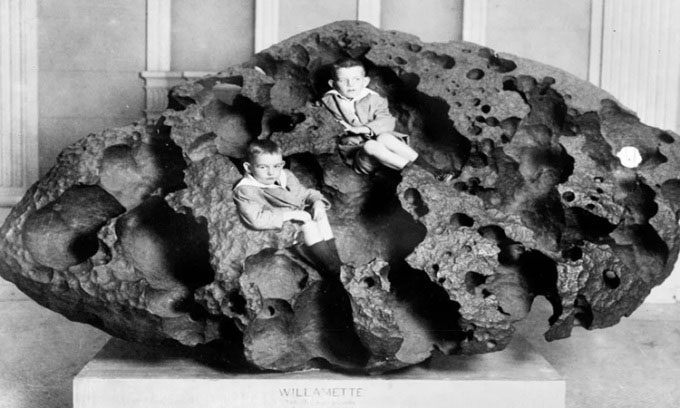The Willamette meteorite, weighing 15.5 tons, was formed during the early days of the Solar System and struck Earth at a speed of over 64,000 km/h before drifting from Canada to the United States.
One of the treasures in the American Museum of Natural History collection is a large extraterrestrial rock known as the Willamette meteorite. Weighing 15.5 tons, it is the largest meteorite ever found in the United States and the sixth largest in the world, according to Amusing Planet.

Two boys sitting inside the hollow of the Willamette meteorite. (Photo: Amusing Planet).
The Willamette meteorite is primarily composed of iron and nickel. Like all iron meteorites, it was formed billions of years ago when the Solar System was still taking shape from cosmic dust. Gravity caused these dust particles to clump together, forming planetesimals, while heavier metals like iron and nickel sank to the center, becoming the core. Later, it is likely that the planetesimal collided with another celestial body, causing it to break apart, with iron-nickel chunks being ejected into space.
Fragments of the planetesimal continued to orbit the Sun for several billion years until about 17,000 years ago, when the orbits of Earth and the Willamette meteorite intersected. The meteorite struck Earth at a speed of over 64,000 km/h in a glacier in western Canada.
Over centuries, glaciers slowly moved the meteorite to Montana, near an ice dam forming on the Clark Fork River. This dam held back a massive amount of water in Lake Missoula. When the meteorite reached the area, the ice dam broke, releasing one of the largest floods ever recorded. Trapped in ice, the meteorite floated down the Columbia River until the ice layer broke apart and the extraterrestrial rock sank to the riverbed, near present-day Portland. At the end of the last Ice Age, receding waters led to the meteorite being exposed. Over thousands of years, rainwater mixed with iron sulfide in the meteorite created sulfuric acid, slowly dissolving many spots on the rock and leaving hollows on its surface.
The meteorite was first discovered by the Clackamas Chinook people, who lived in the Willamette Valley of Oregon before European settlers arrived. They named the meteorite “Tomanowos” and regarded it as sacred. They used the rock in various rituals, using water from the meteorite’s crevices for purification. Before going hunting, tribal hunters would also dip their arrowheads into this water.
In 1902, a miner named Ellis Hughes spotted the meteorite and recognized its significance. He spent three months secretly moving the rock to his home and charged visitors to see it. When the theft was discovered, the legal owner filed a lawsuit and reclaimed it. The company sold the meteorite to William Dodge, who eventually donated it to the American Museum of Natural History in New York.
The Willamette meteorite has been displayed in the museum for nearly a century. In 1999, the Confederated Tribes of Grand Ronde Community of Oregon (CTGRC) requested the return of Tomanowos. By the end of that year, an agreement was established, allowing the meteorite to remain in the museum while tribal members could conduct their own rituals around the rock once a year.


















































